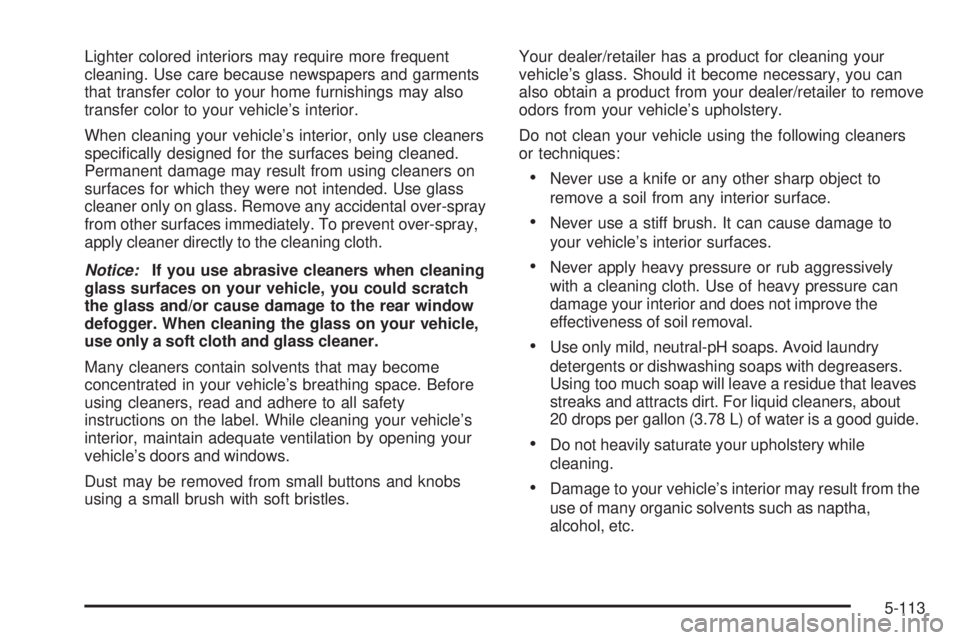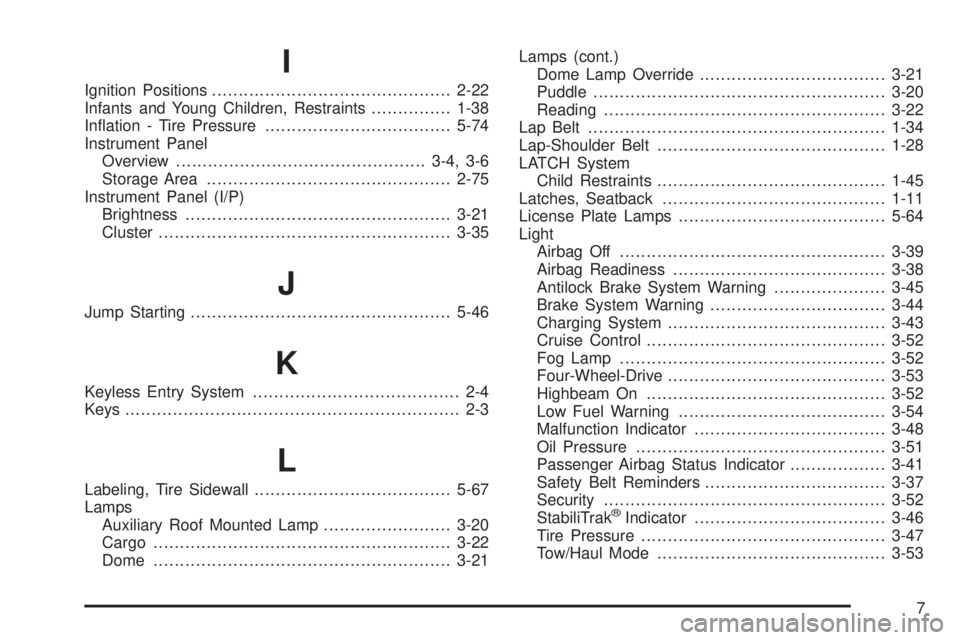2008 GMC SIERRA low oil pressure
[x] Cancel search: low oil pressurePage 238 of 578

ENGINE POWER IS REDUCED
This message displays and a chime sounds when the
cooling system temperature gets too hot and the engine
further enters the engine coolant protection mode.
SeeEngine Overheating on page 5-30for further
information.
This message also displays when the vehicle’s engine
power is reduced. Reduced engine power can affect the
vehicle’s ability to accelerate. If this message is on,
but there is no reduction in performance, proceed
to your destination. The performance may be reduced
the next time the vehicle is driven. The vehicle may
be driven at a reduced speed while this message is on,
but acceleration and speed may be reduced. Anytime
this message stays on, the vehicle should be taken
to your dealer/retailer for service as soon as possible.
FAST IDLE ON
If your vehicle has this feature, this message displays
when the fast idle feature is on. SeeFast Idle System on
page 2-25for more information.
FUEL LEVEL LOW
This message displays and a chime sounds if the fuel
level is low. Refuel as soon as possible. SeeFuel Gage
on page 3-53andFuel on page 5-6for more
information.
HOOD OPEN
This message displays and a chime sounds if the hood is
not fully closed. Stop and turn off the vehicle, check the
hood for obstructions, and close the hood again. Check to
see if the message still appears on the DIC.
LEFT REAR DOOR OPEN (Crew Cab)
This message displays and a chime sounds if the driver
side rear door is not fully closed and the vehicle is in
a drive gear. Stop and turn off the vehicle, check
the door for obstructions, and close the door again.
Check to see if the message still appears on the DIC.
OIL PRESSURE LOW STOP ENGINE
Notice:If you drive your vehicle while the engine
oil pressure is low, severe engine damage may
occur. If a low oil pressure warning appears on the
Driver Information Center (DIC), stop the vehicle
as soon as possible. Do not drive the vehicle until
the cause of the low oil pressure is corrected.
SeeEngine Oil (Gasoline Engine) on page 5-15for
more information.
This message displays if low oil pressure levels occur.
Stop the vehicle as soon as safely possible and do
not operate it until the cause of the low oil pressure has
been corrected. Check the oil as soon as possible
and have your vehicle serviced by your dealer/retailer.
SeeEngine Oil (Gasoline Engine) on page 5-15.
3-66
Page 327 of 578

Other Rainy Weather Tips
Besides slowing down, other wet weather driving tips
include:
Allow extra following distance.
Pass with caution.
Keep windshield wiping equipment in good shape.
Keep the windshield washer �uid reservoir �lled.
Have good tires with proper tread depth. SeeTires
on page 5-66.
Before Leaving on a Long Trip
To prepare your vehicle for a long trip, consider having
it serviced by your dealer/retailer before departing.
Things to check on your own include:
Windshield Washer Fluid:Reservoir full? Windows
clean — inside and outside?
Wiper Blades:In good shape?
Fuel, Engine Oil, Other Fluids:All levels checked?
Lamps:Do they all work and are lenses clean?
Tires:Are treads good? Are tires in�ated to
recommended pressure?
Weather and Maps:Safe to travel? Have up-to-date
maps?
Highway Hypnosis
Always be alert and pay attention to your surroundings
while driving. If you become tired or sleepy, �nd a
safe place to park your vehicle and rest.
Other driving tips include:
Keep the vehicle well ventilated.
Keep interior temperature cool.
Keep your eyes moving — scan the road ahead
and to the sides.
Check the rearview mirror and vehicle instruments
often.
4-29
Page 407 of 578

A. Engine Air Cleaner/Filter. SeeEngine Air
Cleaner/Filter (Gasoline Engines) on page 5-19.
B. Air Filter Restriction Indicator (If Equipped).
SeeEngine Air Cleaner/Filter (Gasoline Engines)
on page 5-19.
C. Coolant Surge Tank and Pressure Cap. SeeCooling
System on page 5-34andCoolant Surge Tank
Pressure Cap on page 5-30.
D. Positive (+) Terminal. SeeJump Starting
on page 5-46.
E. Battery. SeeBattery on page 5-45.
F. Engine Oil Fill Cap. See “When to Add Engine Oil”
underEngine Oil (Gasoline Engine) on page 5-15.
G. Automatic Transmission Dipstick. See “Checking the
Fluid Level” underAutomatic Transmission Fluid
(6-Speed Transmission) on page 5-22orAutomatic
Transmission Fluid (4-Speed Transmission)
on page 5-25.
H. Remote Negative (−) Terminal (Out of View). See
Jump Starting on page 5-46.
I. Engine Oil Dipstick (Out of View). See “Checking
Engine Oil” underEngine Oil (Gasoline Engine)
on page 5-15.
J. Engine Cooling Fan. SeeCooling System
on page 5-34.
K. Power Steering Fluid Reservoir. SeePower Steering
Fluid on page 5-39.L. Brake Master Cylinder Reservoir. See “Brake Fluid”
underBrakes on page 5-42.
M. Underhood Fuse Block. SeeUnderhood Fuse Block
on page 5-126.
N. Windshield Washer Fluid Reservoir. See “Adding
Washer Fluid” underWindshield Washer Fluid
on page 5-40.
Engine Oil (Gasoline Engine)
If your vehicle has a diesel engine, see “Engine Oil” in
the DURAMAX®Diesel manual.
Checking Engine Oil
It is a good idea to check the engine oil every time you
get fuel. In order to get an accurate reading, the oil
must be warm and the vehicle must be on level ground.
The engine oil dipstick handle is a yellow loop. See
Engine Compartment Overview on page 5-14for
the location of the engine oil dipstick.
1. Turn off the engine and give the oil several minutes
to drain back into the oil pan. If you do not do this,
the oil dipstick might not show the actual level.
2. Pull out the dipstick and clean it with a paper towel
or cloth, then push it back in all the way. Remove it
again, keeping the tip down, and check the level.
5-15
Page 428 of 578

How to Add Coolant to the Coolant
Surge Tank for Gasoline Engines
If your vehicle has a diesel engine, see “Cooling
System” in the DURAMAX®Diesel Supplement for the
proper coolant �ll procedure.
If you have not found a problem yet, check to see if
coolant is visible in the surge tank. If coolant is visible
but the coolant level is not at or above the FULL COLD
mark, add a 50/50 mixture of clean, drinkable water and
DEX-COOL
®coolant at the coolant surge tank, but be
sure the cooling system, including the coolant surge tank
pressure cap, is cool before you do it. SeeEngine
Coolant on page 5-28for more information.
If no coolant is visible in the surge tank, add coolant
as follows:
{CAUTION:
Steam and scalding liquids from a hot cooling
system can blow out and burn you badly. They
are under pressure, and if you turn the coolant
surge tank pressure cap — even a little — they
can come out at high speed. Never turn the
CAUTION: (Continued)
CAUTION: (Continued)
cap when the cooling system, including the
coolant surge tank pressure cap, is hot. Wait
for the cooling system and coolant surge tank
pressure cap to cool if you ever have to turn
the pressure cap.
{CAUTION:
Adding only plain water to your cooling system
can be dangerous. Plain water, or some other
liquid such as alcohol, can boil before the
proper coolant mixture will. Your vehicle’s
coolant warning system is set for the proper
coolant mixture. With plain water or the wrong
mixture, your engine could get too hot but you
would not get the overheat warning. Your
engine could catch �re and you or others could
be burned. Use a 50/50 mixture of clean,
drinkable water and a proper coolant.
5-36
Page 505 of 578

Lighter colored interiors may require more frequent
cleaning. Use care because newspapers and garments
that transfer color to your home furnishings may also
transfer color to your vehicle’s interior.
When cleaning your vehicle’s interior, only use cleaners
speci�cally designed for the surfaces being cleaned.
Permanent damage may result from using cleaners on
surfaces for which they were not intended. Use glass
cleaner only on glass. Remove any accidental over-spray
from other surfaces immediately. To prevent over-spray,
apply cleaner directly to the cleaning cloth.
Notice:If you use abrasive cleaners when cleaning
glass surfaces on your vehicle, you could scratch
the glass and/or cause damage to the rear window
defogger. When cleaning the glass on your vehicle,
use only a soft cloth and glass cleaner.
Many cleaners contain solvents that may become
concentrated in your vehicle’s breathing space. Before
using cleaners, read and adhere to all safety
instructions on the label. While cleaning your vehicle’s
interior, maintain adequate ventilation by opening your
vehicle’s doors and windows.
Dust may be removed from small buttons and knobs
using a small brush with soft bristles.Your dealer/retailer has a product for cleaning your
vehicle’s glass. Should it become necessary, you can
also obtain a product from your dealer/retailer to remove
odors from your vehicle’s upholstery.
Do not clean your vehicle using the following cleaners
or techniques:
Never use a knife or any other sharp object to
remove a soil from any interior surface.
Never use a stiff brush. It can cause damage to
your vehicle’s interior surfaces.
Never apply heavy pressure or rub aggressively
with a cleaning cloth. Use of heavy pressure can
damage your interior and does not improve the
effectiveness of soil removal.
Use only mild, neutral-pH soaps. Avoid laundry
detergents or dishwashing soaps with degreasers.
Using too much soap will leave a residue that leaves
streaks and attracts dirt. For liquid cleaners, about
20 drops per gallon (3.78 L) of water is a good guide.
Do not heavily saturate your upholstery while
cleaning.
Damage to your vehicle’s interior may result from the
use of many organic solvents such as naptha,
alcohol, etc.
5-113
Page 570 of 578

Fuel (cont.)
Fuels in Foreign Countries.............................. 5-9
Gage.........................................................3-53
Gasoline Octane........................................... 5-6
Gasoline Speci�cations.................................. 5-6
Low Warning Light.......................................3-54
Fuses
Center Instrument Panel Fuse Block.............5-125
Fuses and Circuit Breakers.........................5-123
Instrument Panel Fuse Block.......................5-124
Underhood Fuse Block...............................5-126
Windshield Wiper.......................................5-123
G
Gage
Engine Coolant Temperature.........................3-46
Fuel..........................................................3-53
Oil Pressure...............................................3-50
Speedometer..............................................3-36
Tachometer.................................................3-36
Voltmeter Gage...........................................3-43
Garage Door Opener.......................................2-68
Gasoline
Octane........................................................ 5-6
Speci�cations............................................... 5-6
Glove Box.....................................................2-74
GM Mobility Reimbursement Program.................. 7-6
H
Hazard Warning Flashers................................... 3-8
Head Restraints..............................................1-10
Headlamp
Aiming.......................................................5-56
Headlamps....................................................5-60
Bulb Replacement.......................................5-59
Daytime Running Lamps...............................3-18
Exterior Lamps............................................3-17
Flash-to-Pass..............................................3-11
Halogen Bulbs............................................5-59
High/Low Beam Changer..............................3-11
On Reminder..............................................3-18
Pickup Box Identi�cation and Fender
Marker Lamps.........................................5-62
Heated Seats................................................... 1-6
Heater...................................................3-25, 3-27
Heater...........................................................3-28
Highbeam On Light.........................................3-52
Highway Hypnosis...........................................4-29
Hill and Mountain Roads..................................4-30
Hood
Checking Things Under................................5-12
Release.....................................................5-13
Horn............................................................... 3-8
How to Wear Safety Belts Properly...................1-19
6
Page 571 of 578

I
Ignition Positions.............................................2-22
Infants and Young Children, Restraints...............1-38
In�ation - Tire Pressure...................................5-74
Instrument Panel
Overview...............................................3-4, 3-6
Storage Area..............................................2-75
Instrument Panel (I/P)
Brightness..................................................3-21
Cluster.......................................................3-35
J
Jump Starting.................................................5-46
K
Keyless Entry System....................................... 2-4
Keys............................................................... 2-3
L
Labeling, Tire Sidewall.....................................5-67
Lamps
Auxiliary Roof Mounted Lamp........................3-20
Cargo........................................................3-22
Dome........................................................3-21Lamps (cont.)
Dome Lamp Override...................................3-21
Puddle.......................................................3-20
Reading.....................................................3-22
Lap Belt........................................................1-34
Lap-Shoulder Belt...........................................1-28
LATCH System
Child Restraints...........................................1-45
Latches, Seatback..........................................1-11
License Plate Lamps.......................................5-64
Light
Airbag Off..................................................3-39
Airbag Readiness........................................3-38
Antilock Brake System Warning.....................3-45
Brake System Warning.................................3-44
Charging System.........................................3-43
Cruise Control.............................................3-52
Fog Lamp..................................................3-52
Four-Wheel-Drive.........................................3-53
Highbeam On.............................................3-52
Low Fuel Warning.......................................3-54
Malfunction Indicator....................................3-48
Oil Pressure...............................................3-51
Passenger Airbag Status Indicator..................3-41
Safety Belt Reminders..................................3-37
Security.....................................................3-52
StabiliTrak
®Indicator....................................3-46
Tire Pressure..............................................3-47
Tow/Haul Mode...........................................3-53
7